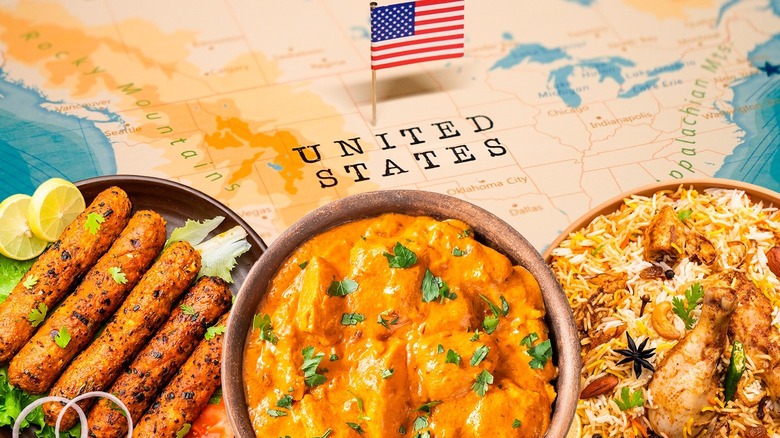One of the most distinctive and praiseworthy elements of the United States culinary landscape is its diversity. Within a short drive, you can find ever-popular Mexican fare, Southern soul food, and dazzling Italian eateries, to name a few. However, one cuisine — lauded for combining timeless tradition with compelling new flavors — is gaining increasingly more traction. Can you guess which? You got it: Indian food.
Particularly in cities, Indian cuisine has put itself on the map in a big way. New York and Los Angeles have seen an influx of Indian fine dining, and some restaurant have even gained prestigious Michelin stars. Smaller cities have restaurants brimming with more plates than you could picture, plus bijou curry houses with tempting takeout options.
Although Indian cuisine harbors a wealth of scrumptious choices, some dishes have found more devotees than others (think butter chicken and naan, for example). But is your go-to order in the top 15 Indian dishes in the U.S.? Here’s which dishes have more than tantalized Americans’ tastebuds — and don’t blame us if you develop a sudden desire to get Indian takeout!
Biryani
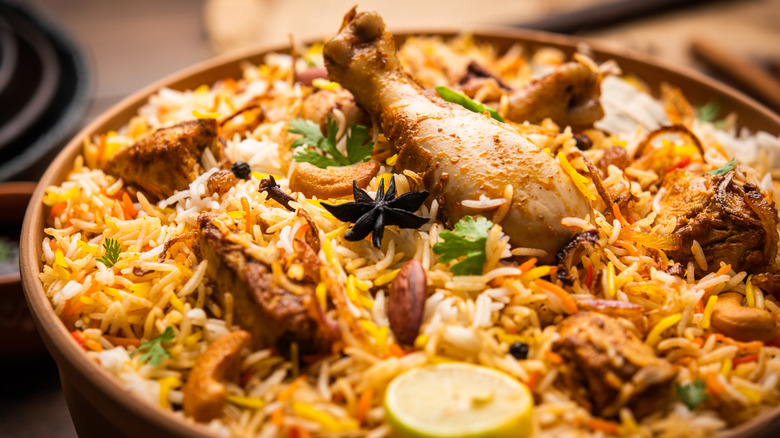
Rice dishes at Indian restaurants are always a treat. Long, fluffy grains of rice scented with floral and warming spices are just the beginning. Biryani, an awe-dropping pot of saffron-tinged rice layered with caramelized onions, yogurt-marinated proteins or vegetables, chopped nuts, and fresh herbs, is high on our list of the most impressive dishes you can order. Traditionally, chefs cook the meal in a clay pot, sealed at the top with dough, and then carefully steamed until tender and aromatic. It’s incomplete unless plated alongside cooling raita and crunchy papad (more on papad later!), making the experience a mind-boggling explosion of flavors, textures, and colors.
Better yet? Biryani is a crowd-pleaser and suitable for almost anyone. There’s a variation for every lifestyle choice and diet: vegan jackfruit biryani, vegetarian paneer or egg biryani, celebratory lamb biryani, or legendary meaty Hyderabad chicken biryani. Moreover, unlike other rice dishes such as pulao, biryani is substantial enough to be a stand-alone meal.
Chicken tikka masala
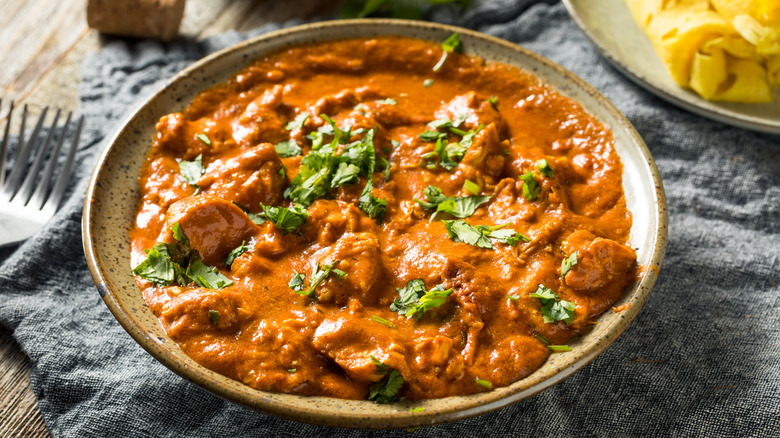
We owe the creation of beloved crowdpleaser chicken tikka masala to a curry-loving country — but it’s not the one you may expect. The pioneer of chicken tikka masala, Ali Ahmed Aslam, was a Pakistani-born British citizen who spent most of his life in Glasgow, Scotland. While working in a local restaurant, he notoriously invented the dish that would soon take over the U.K. — and later the U.S.
While chicken tikka masala doesn’t have quite the same celebrity status in the U.S. as in its birthplace, the saucy dish is undeniably in demand. Likely one of the Indian dishes foremost in people’s minds, it’s not only become a restaurant staple but has also worked its way into the world of prepared grocery-store meals and airplane fare. After all, the dish is indisputably appealing. With tender, succulent pieces of chicken marinated in yogurt that’s tangy, aromatic, creamy, and only mildly spicy — some restaurants infuse notes of sweetness, too — classic chicken tikka masala is one of the most delicious common Indian dishes, boasting complex yet non-overwhelming flavors.
Vegetable samosa
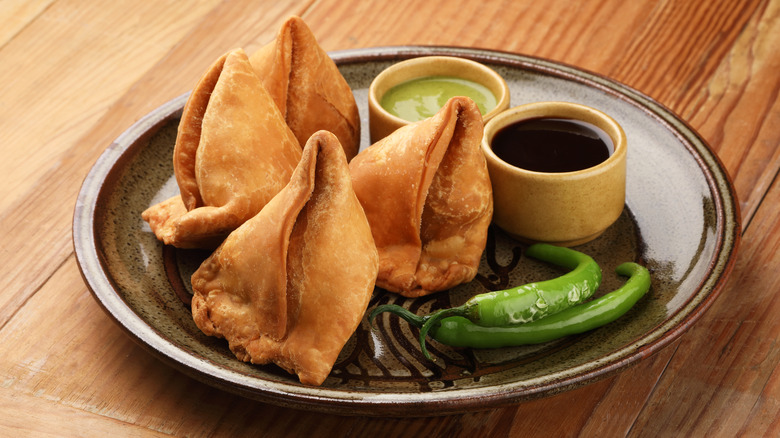
asmiphotoshop/Shutterstock
Many people incorrectly surmise that Indian food is all about curry (the origin of the word “curry” itself is a highly disputed topic). That assumption does a real disservice to the fascinating and inviting array of appetizers available at Indian restaurants; from pani puri, India’s beloved chaat, to onion bhaji or pakora — there’s no shortage of choice. Nonetheless, one is consistently more sought-after in the U.S. than any other: the vegetable samosa.
Filled with a lip-smackingly messy mash of soft potatoes, fresh peas, and vibrant, zesty spices encased in a crisp, flaky pastry, the best way to eat the treat is by diving right in with your hands — no need to fuss with a knife and fork. Most restaurants also provide sumptuous chutneys and yogurt-based cooling raita for dunking the samosa, only further boosting its popularity.
You’ll mainly find two types of samosa in U.S. restaurants. Firstly, Punjabi samosa showcases characteristic pyramid-shaped domes and thick, crunchy pastry. Secondly, yet every bit as delicious, the phyllo-wrapped samosa is smaller and more delicate, marked by the pastry’s distinctive brittle snap. The latter is more common in all-you-can-eat buffets.
Rogan josh
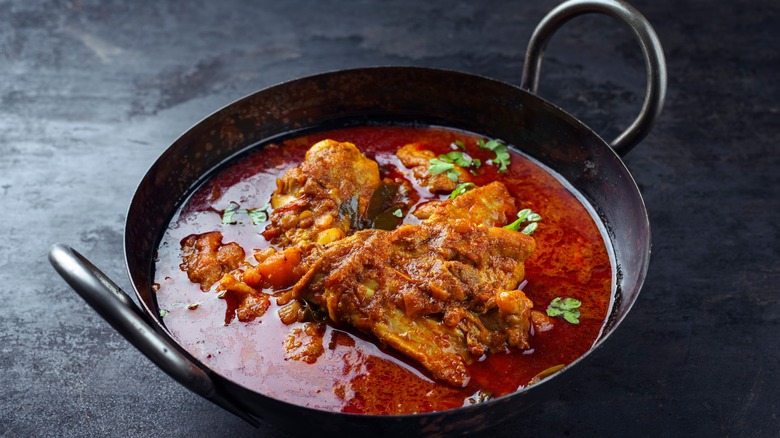
hlphoto/Shutterstock
Marked by its blazing red color and rich, deep, and intensely meaty sauce, rogan josh is a restaurant mainstay. Originating in India’s northwestern state of Kashmir, the dish has stayed a regional secret within India. By contrast, thousands of miles away in the U.S., rogan josh has only increased its mainstream appeal. Its moniker gives hints to the genesis and taste of the dish; “rogan” translates to “oil,” while “josh” means “to braise,” hence “to braise in oil.” The slow cooking draws out the powerful savoriness of typical Kashmiri seasoning — dried ginger and fennel — while rendering the goat meat soft and juicy, ready to fall off the bone.
Part of the appeal is the layer of red oil floating on top of the dish — a pleasing indication the dish is cooked well. In traditional Kashmiri households, the distinctive color arises from a herb known as ratan jog combined with fruity Kashmiri chili powder and freshly strained curd. Modern restaurants replace the sourness of yogurt with tomatoes simmered until the sauce is thick and glossy, ideal for serving with rice.
Aloo gobi
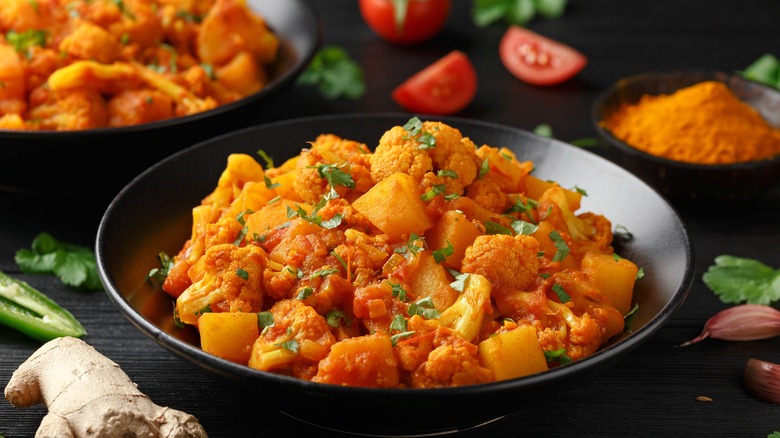
DronG/Shutterstock
When it comes to vegetable side dishes, aloo gobi is the leader of the pack. Boasting tender, buttery cauliflower with melt-in-your-mouth potato chunks simmered in a thick, tomatoey sauce that coats each crevice with fiery heat, garlicky aromas, and earthy spice — complex, layered flavors highlight the best of humble ingredients. That’s why you’ll see crowds of diners who usually wouldn’t dream of ordering vegetable dishes religiously opting for this one.
Besides, the hearty ingredients marry exceptionally well with meats and other side dishes, particularly chickpea curry, lentil dal, pulao rice, or roti. In other words, it’s a quintessential side dish. In contrast to other dishes that are adapted for — or, in some cases, created for — the Western palate, aloo gobi served in U.S.-based Indian restaurants accurately represents traditional, homey Indian food. That means it’s likely to have a hoard of NRI (non-resident Indian) fans, and if you’re looking for authentic taste, it’s likely to please.
Butter chicken
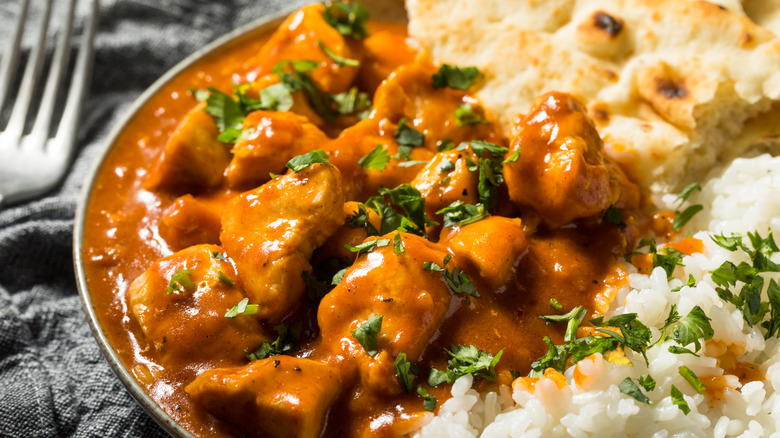
Bhofack2/Getty Images
Few dishes, Indian or otherwise, are as iconic as butter chicken. Despite being a relatively modern dish compared to other quintessential Indian dishes — court cases over the true inventor of butter chicken indicate a history stretching back only about 70 years — butter chicken has a devoted following both in India and abroad.
Butter chicken is indulgent, rich, and creamy, and it’s no wonder that it’s never failed to impress. The chicken pieces boast an unbelievably tender and succulent texture, yet unequivocally, the sauce is the star of the show. Enriched with aromatic spices such as cardamom, mace, and garam masala, it’s punctured with bitter fenugreek leaves, creamy cashews, honeyed sweetness, and rich tomatoes. One of our favorite renditions of this archetypal curry dish comes from Maneesh Goyal, restauranteur and principal owner of Manhattan-based fine-dining restaurant Sona. This exclusive butter chicken recipe is a time-honored family heirloom, first served in his parent’s first restaurant, India House, in the ’70s. It’s a fabulous way to recreate your restaurant favorites from the comfort of your own home.
Poppadoms and chutney
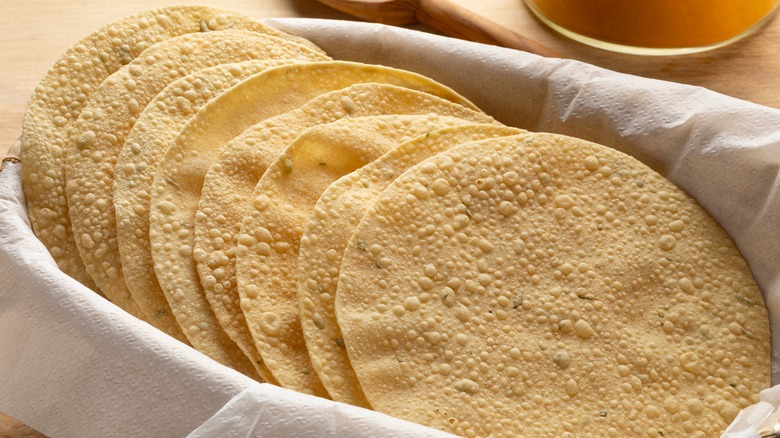
Picture Partners/Shutterstock
There’s tortilla chips and salsa at Mexican restaurants, and then there’s bread with balsamic dipping oil at Italian restaurants. But at Indian eateries, it’s all about poppadoms (also called papad or papadam, depending on the region) with chutney. Some people consider eating poppadoms before your meal one of the biggest mistakes you can make when eating at an Indian restaurant, drawing attention to the idea you’ll get too full before the “proper” meal starts, but that doesn’t change the fact they’re an integral and popular part of most diners’ experiences.
Poppadoms are crisp, thin, and light with a mild, nutty flavor. This neutral flavor and flat shape make them ideal for breaking off and plunging into tart tamarind dip, minty green sauce, sugared mango chutney, or punchy chopped onions. Most restaurants offer the basic urad dal (black lentil) based poppadoms, but more authentic places may have rice, wheat, or tapioca-based crisps to munch on while you wait for your mains and sides. The delightfully moreish nature of poppadoms, combined with how they make the wait for your entrées more enjoyable, makes these nibbles widely adored.
Vindaloo
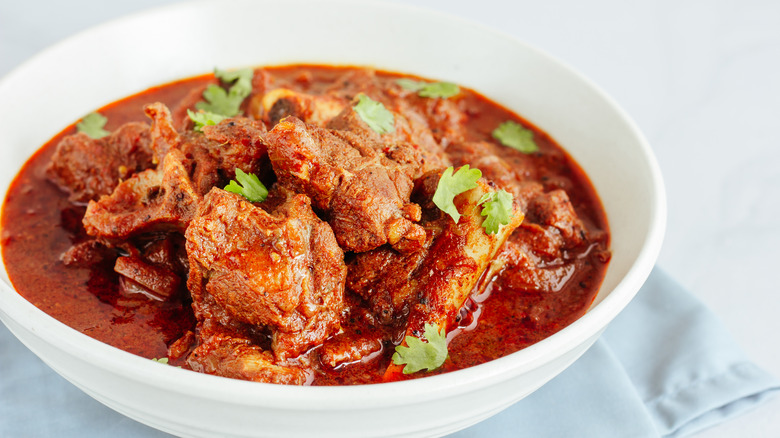
Ravsky/Shutterstock
If you’re craving spicy, piquant food, vindaloo is for you — and countless others feel the same way. Notorious for its eye-watering spice level, many curry lovers gather to see who can brave the bowls and come out the champion. Of course, vindaloo isn’t all about heat — it has an undercurrent of warm spice accented by vinegar, too.
Interestingly, vindaloo has complex origins dating back to Portugal’s colonization of India — and, more specifically, the southwestern state of Goa. The dish’s name — and subsequent transliteration — has led to much confusion, with foodies debating whether the dish should contain wine and garlic (as with the original Portuguese dish, vinha d’alhos) or vinegar and potatoes (stemming from the Hindi name for potato being “aloo”). Most Western restaurants opt for the latter, packing the bowl with hearty chunks of buttery, fall-apart spuds alongside the slightly sweet pork. While few of the original Goan flavors remain in the U.S. version today, its evolution isn’t inferior to the source recipe; the thick, fiercely spicy sauce is enough to make your mouth water all on its own.
Palak paneer
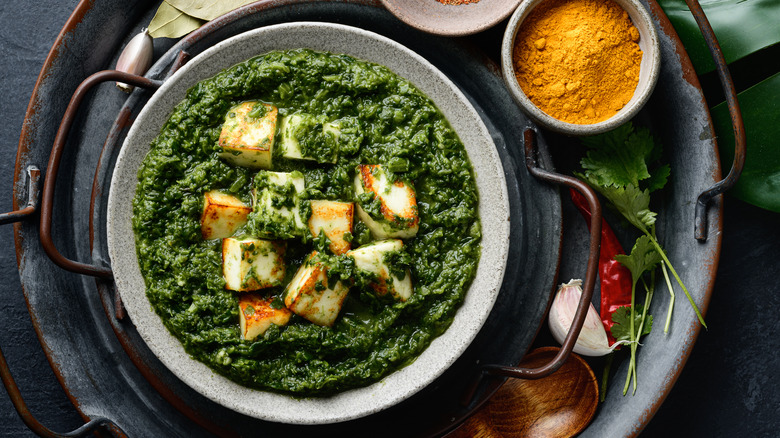
Chzu/Shutterstock
Cheese is divisive. From the almost universally loved mozzarella to contentious blue cheese, people either love or hate the stuff — and paneer is no exception. Paneer is a non-aged, fresh, and mild cheese made by curdling milk and pressing the curds until firm. While some bemoan the creamy yet firm texture, it has enough fans to earn a best-selling spot on most restaurant menus. Since it doesn’t melt under heat, it’s excellent for adding to curries such as simple palak paneer, a creamy spinach-packed curry bursting with garlicky, buttery flavors.
Palak paneer doubles as a side dish for a meat-based entrée or as a main, especially for vegetarian diners. In fact, it’s delectable when married with naan, onion pakora, and a sharp pickle to cut through the richness. Considering its wholesome and herby sauce, the plate offers a markedly different affair than the typical onion and tomato-heavy dishes, explaining its hot reputation.
Korma
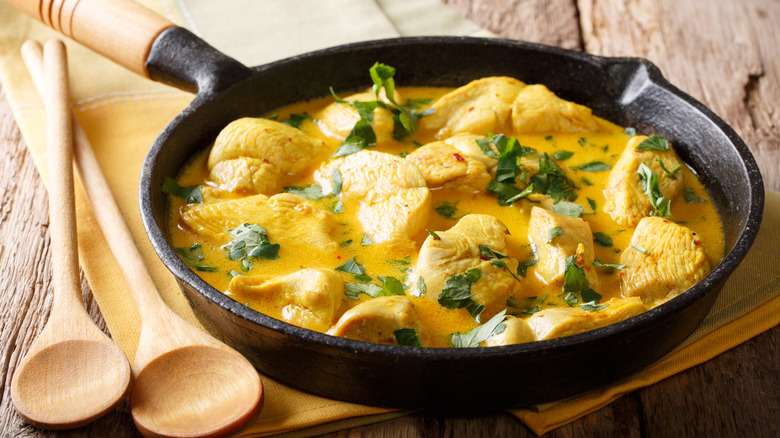
AS Foodstudio/Shutterstock
No spice tolerance? No problem. If you prefer rich, indulgent dishes with more aroma than heat, look no further than korma, which has become a best-selling Indian restaurant dish. The Western version is mildly spiced, subtly sweet, and laden with ghee, boasting a creamy, velvety texture from its coconut powder, coconut block, almonds, and heavy cream. Often, restaurants will give you the choice of lamb, paneer, vegetable, or chicken korma.
However, in South Asia, korma has a very different connotation. Pakistani and North Indian variants often involve more than a dozen spices, yogurt, and kewra water for pleasant, perfumed notes. Veggie-packed navratan korma (meaning “nine jewels” for the dish’s nine vegetables) follows the Mughlai white gravy style, involving a paste made from poppy and melon seeds, almonds, and cashews. Fresh and zesty cilantro scattered on top seals the deal.
While the Western version remains slightly more widespread in the U.S. (probably due to the lower spice levels and gentle sweetness), if you’re an Indian food fanatic, it’s worth grabbing the opportunity to taste authentic korma if you spot it on the menu. Why not try both versions and compare them based on your personal taste?
Tandoori chicken
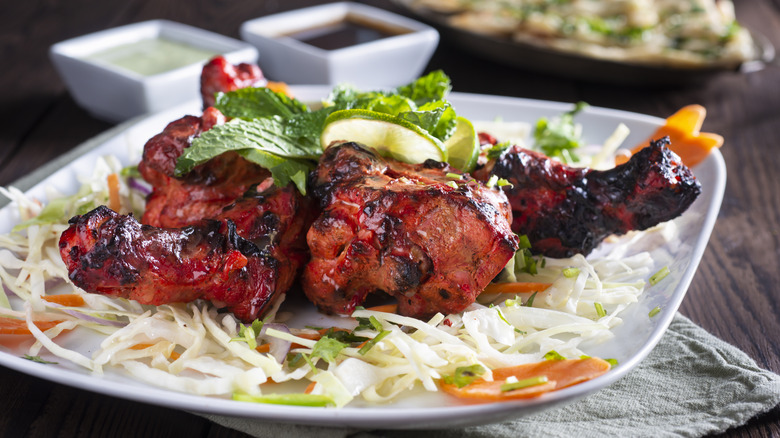
Rudisill/Getty Images
Charred, bright red, and infused with the smoky coals from the tandoor (a large, vase-shaped, and coal-fired oven), tandoori chicken is a fundamental part of eating out at a curry house for many people. Although the dish is considerably older, it began to pick up favor in the U.S. around the ’60s. As the legend goes, then-First Lady Jacqueline Kennedy snacked on “chicken tandoori” on a transcontinental flight out of India, and it wasn’t long before the LA Times published a recipe for the dish. Then, it began to emerge on menus nationwide. Around this time, a cultural shift occurred: No longer were people denouncing all Indian food as “just curry” — instead, they began acknowledging that there are, indeed, thousands of specialty dishes in the country’s cuisine that didn’t fit the stereotype.
We can understand why tandoori chicken was the catalyst for this movement, too. Marinating the meat is the secret to the best tandoori chicken, rendering it tender, moist, and juicy, plus infusing it with layers of mint, fenugreek, and sophisticated spices. You simply can’t go wrong with this delectable dish.
Garlic naan
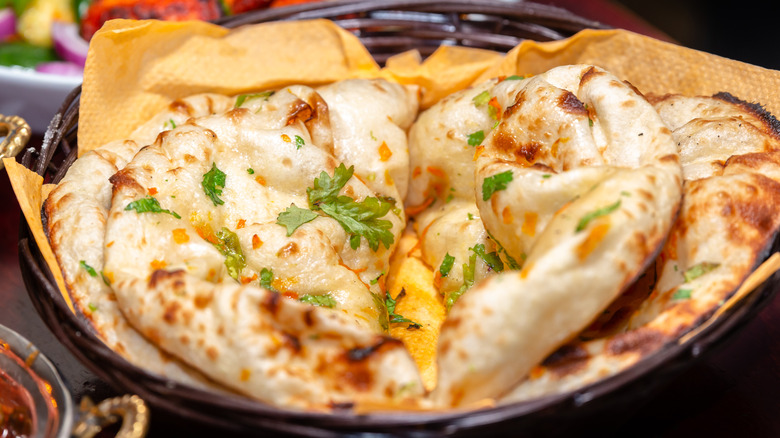
Finn stock/Shutterstock
Indian restaurants don’t receive nearly as much recognition for their bread selections as they should, with menus frequently advertising laccha paratha, rumali roti, puri, bhatura, and sweet, lentil-stuffed flatbread — at a minimum. Most diners, however, have an unwritten rule about Indian dining — you must order at least one naan (and yes, that’s naan, not “naan bread”).
While most Indian breads are unleavened (flatbreads without yeast), naan is an exception. It’s fluffy, pillowy, soft, and bubbly. In other words, it’s perfect for mopping up creamy sauces, scooping vegetables, or swaddling kebabs. Nearly all Indian restaurants have a built-in tandoor, especially for cooking naan. The technique delivers an irresistible char and specific smoky flavor that only adds sophistication to every mouthful.
Since naan is a bestseller, it’s no surprise there are usually countless variations to tempt. We’re talking about chili-infused, stuffed with sweet nuts and fruits, naan oozing with gooey cheese, plain, and naan brushed with rich, salty butter. Our nation’s favorite? Without question, garlic naan with fresh cilantro.
Dosa sambar
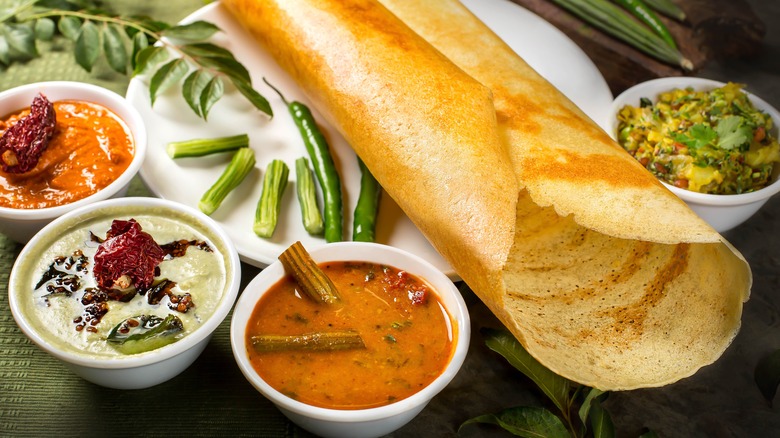
camfine/Shutterstock
Historically, Punjabi food has dominated the Indian food landscape outside of South Asia due to a considerable diaspora. However, that’s all changing, with more restaurants focusing on the previously largely unexplored regional cuisines that cover almost half of India’s land mass. Thousands have popped up over the U.S. in the last few decades, particularly in big cities. Nonetheless, South Indian delicacies remain on the periphery of public attention, except one: dosa sambar.
Dosa is made from a fermented batter of ground rice and lentils, then spread on a cast iron tawa and cooked like a crepe. The result will be soft and fluffy, crisp and golden, or paper thin and delicate, depending on the proportion of rice to lentils, but all have a signature mildly tangy flavor. Aiding its high regard are its traditional accompaniments: sambar, a spicy lentil-based dish with fresh vegetables; nutty coconut chutney; tomato chutney tempered with curry leaves; and mildly spiced potatoes.
Malai kofta
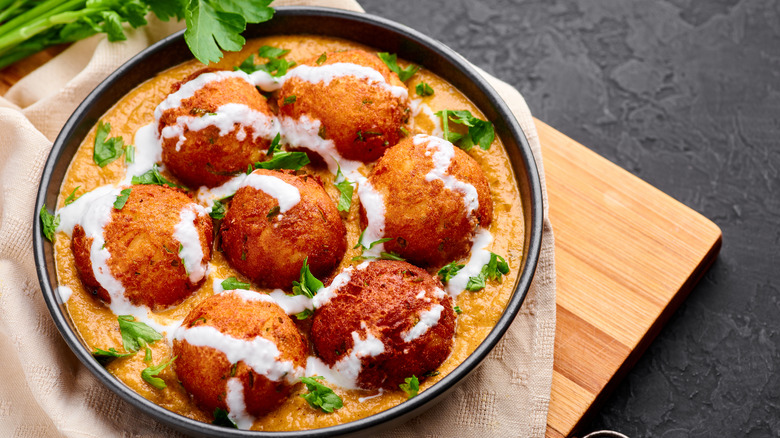
Kravtzov/Shutterstock
Of all global cuisines, Indian food likely ranks highest for vegetarian-friendly fare. With a study from the Pew Research Center showing that 39% of respondents identify as living vegetarian lifestyles, it’s no wonder Indian chefs and home cooks have invented some truly lip-smacking meat-free dishes. Primary among them is malai kofta, an adaptation of traditional meat kofta. Soft potato mixed with grated paneer, stuffed with nuts and dried fruits, seasoned to perfection, shaped into balls, and fried until golden will make you forget the minced meat version ever existed.
And the sauce? It’s a dreamy affair. Whole spices — think woodsy cinnamon, pungent cloves, floral cardamom, and many others — are sautéed in butter to draw out their flavors and fragrances before building a foundation with onions, garlic, ginger, tomatoes, and dried spices. Once passed through the blender and combined with cream, you’ve got the silkiest, most buttery sauce imaginable. Malai kofta is wholesome and robust, meaning it’s generally relished as a main course, and it’s often ordered with naan, raita, pulao, and salted lassi for the best experience.
Seekh kebab
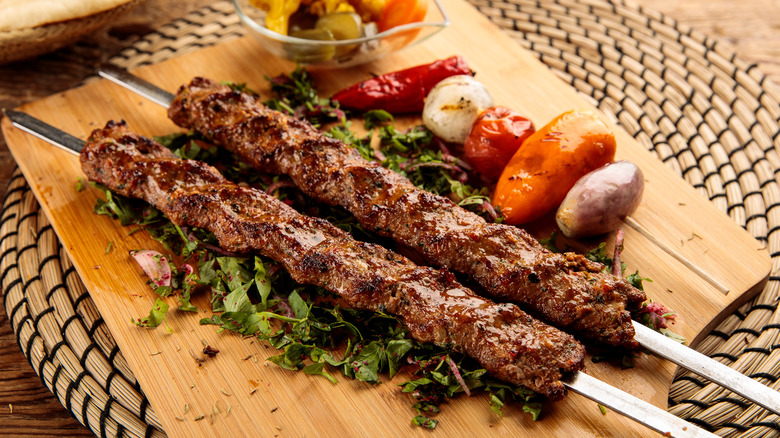
Waqar Hussain/Getty Images
From Middle Eastern kabobs to Japanese yakitori, barbecued vegetable skewers, and South Asian satay, it’s clear to see that the world is smitten with meat on a stick. Naturally, Indian cuisine contributes to this list with its ever-popular seekh kebabs. Despite their humble appearance, the skewers are richly seasoned and delightfully fatty. The juicy lamb mince (chicken and beef can also make an appearance, but rarely the latter) has flavors from finely chopped garlic, shallots, ginger, and green chilis, plus cumin, coriander, turmeric, and either garam masala or basaar mix for a kick of well-rounded heat.
Typically listed under the “grill” section of the menu, seekh kebabs are typically presented on a bed of finely sliced cabbage with a fresh, herby kachumber salad (tomato, onion, and cucumber with a citrus dressing) and a turmeric-spiced yogurt dip on the side. Pillowy naan is all you need to make the meal a substantial course or whet your appetite with the kebabs before moving on to saucier things.
Static Media owns and operates Look, Mashed, and The Daily Meal.



